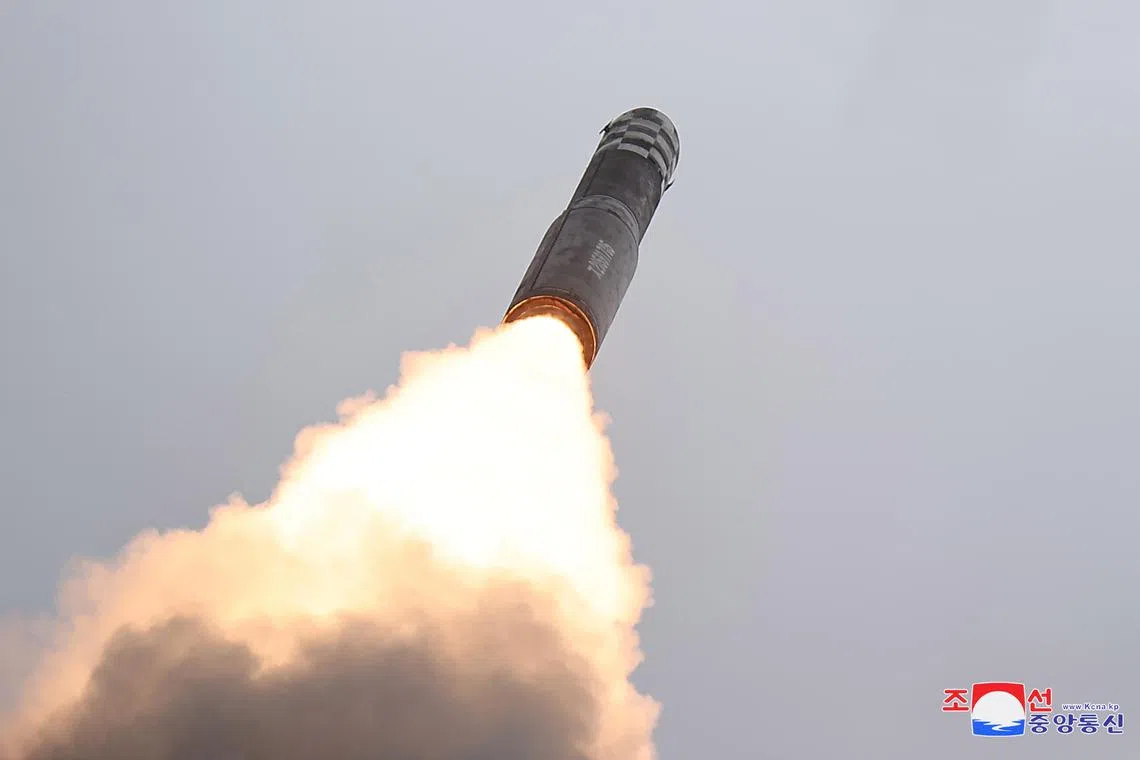North Korea fires two missiles after arrival of US nuclear submarine in South Korea
Sign up now: Get insights on Asia's fast-moving developments

North Korea test-firing a Hwasong-18 intercontinental ballistic missile in a picture released last week.
PHOTO: EPA-EFE
Follow topic:
SEOUL – North Korea fired two ballistic missiles eastwards early on Wednesday, the Japanese and South Korean militaries said, just hours after a United States ballistic missile submarine
The USS Kentucky, an Ohio-class nuclear-armed SSBN, made port in the south-eastern city of Busan. Its arrival coincided with the start of talks among the allies to coordinate responses in the event of a nuclear war with North Korea.
South Korean President Yoon Suk-yeol, aboard the submarine, said its arrival highlighted the alliance’s resolve to deploy US strategic assets and improve the capabilities of the American nuclear umbrella.
“We will make it impossible for North Korea to ever think of a nuclear provocation, and have clearly warned that if it does, it will lead to the end of its regime,” Mr Yoon said in a speech. Both the missiles appeared to have fallen outside Japan’s exclusive economic zone, the Japanese Defence Ministry said.
South Korea’s Joint Chiefs of Staff (JCS) called on the North to cease such launches.
“We strongly condemn North Korea’s successive ballistic missile launches as grave provocative acts that undermine the peace and stability of the Korean peninsula as well as the international community, and are a clear violation of UN Security Council resolutions,” the JCS said.
The US military said it was aware of the launches and consulting closely with allies and partners.
The launches do not appear to pose an immediate threat to the US or its allies, but the events highlight the destabilising impact of North Korea’s illicit weapons programme, the US Indo-Pacific Command said. The first missile reached an altitude of 50km and covered a range of 550km. The second rose as high as 50km and flew 600km, Japanese Defence Minister Yasukazu Hamada said.
Tokyo lodged a protest through diplomatic channels, he said.
The launches are the latest in a series of weapon tests by Pyongyang, and come as Seoul and Washington ramp up defence cooperation in the face of soaring tensions with the North.
On Tuesday, they held the first Nuclear Consultative Group meeting in Seoul and announced an American nuclear submarine was making a port visit to Busan
The move had been expected to trigger a strong response from North Korea, which baulks at having US nuclear assets deployed around the Korean peninsula.
The firing comes nearly a week after North Korea tested its latest Hwasong-18
Diplomacy between Pyongyang and Seoul has stalled and North Korean leader Kim Jong Un has called for ramping up weapon development, including tactical nuclear types.
In response, Seoul and Washington have staged joint military exercises
The launches also come as Washington confirmed on Tuesday that a US soldier is believed to have been detained by North Korea
“North Korea’s latest firing of ballistic missiles is probably unrelated to an American soldier crossing the inter-Korean border, but such an incident doesn’t help matters either,” said Dr Leif-Eric Easley, a professor at Ewha University in Seoul.
North Korea “undoubtedly opposes” a new US-South Korea nuclear war planning group and the visit of the submarine, he added. REUTERS, AFP

